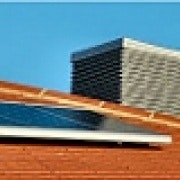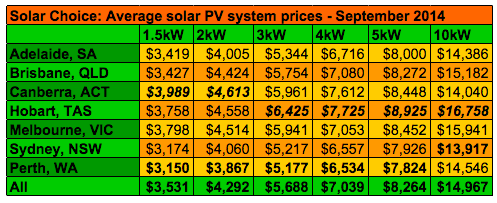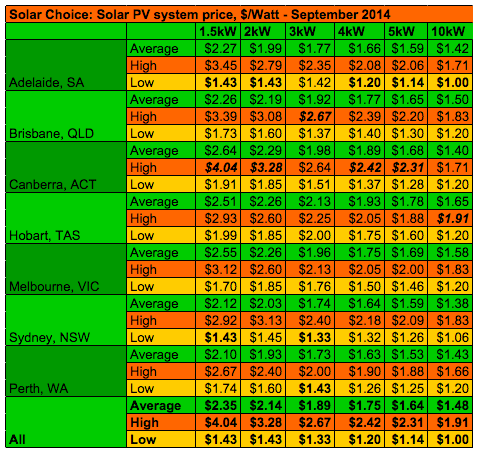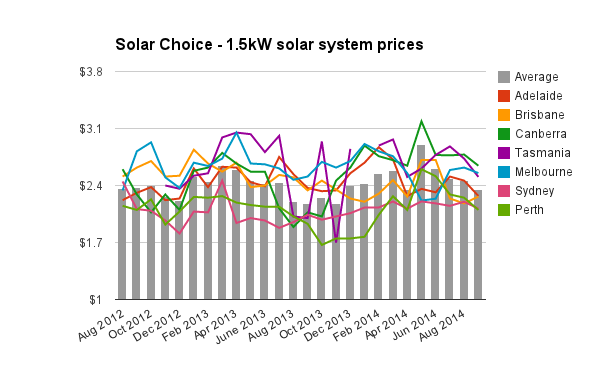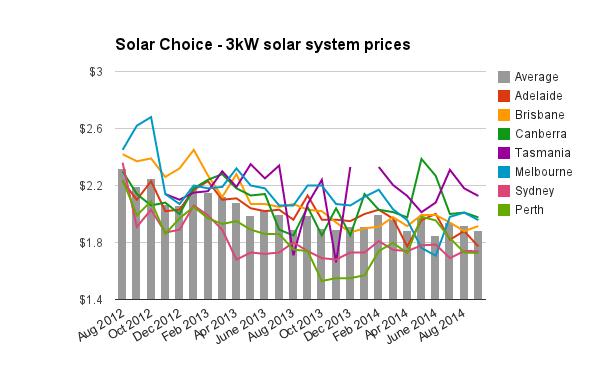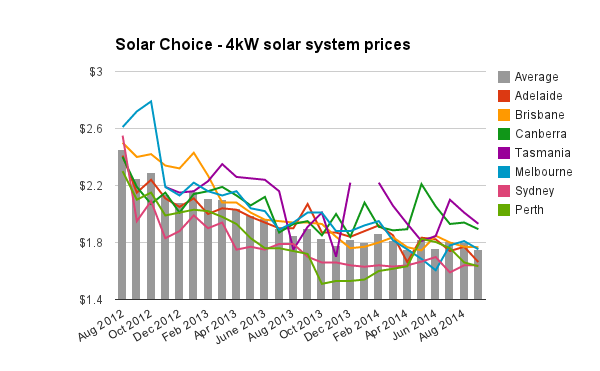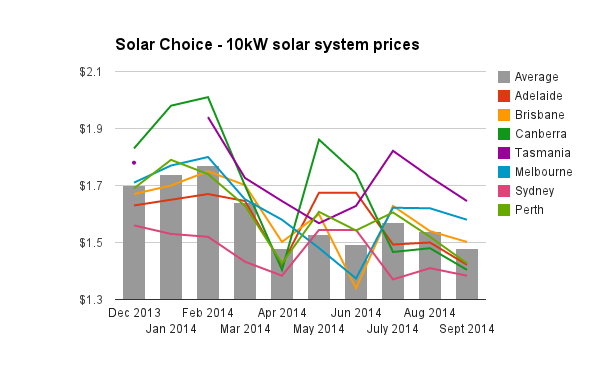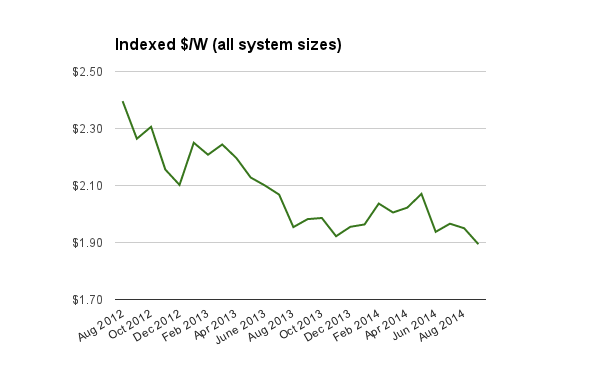Solar PV price check - September
Average residential solar system prices dipped across the board between August and September, with almost no instances in which they increased.
The trend was likely spurred by the recent release of the Renewable Energy Target review panel's recommendations that the scheme be abolished or significantly scaled back, with a number solar installation companies lowering prices to increase competitiveness as demand surges in anticipation of cuts to the subsidy for small-scale (<100kW) systems.
The miniature boom that the announcement set off seems to be the cause of the fall in indexed average prices to an unprecedented $1.90 per watt (after STC subsidy) – the lowest seen since Solar Choice began keeping records in August 2012. Importantly, the continuing decrease in retail prices (which are for a full installation, after the STC subsidy provided through the RET) stands in contrast to trends in the cost of solar PV modules. The following chart, included in Solar Business Services’ submission to the RET review panel, captures how global solar PV module prices have changed since February 2012. In particular, the chart highlights the exaggerated inflationary effect that the foreign exchange rates have on the wholesale cost of modules imported to Australia.
Source: Solar Business Services
Since only one solar panel manufacturer operates domestically here, virtually all of the solar panels used in Australian installations are imported from abroad. The takeaway from the above chart, when looked at in conjunction with the ones below, is that installation companies are likely to be feeling a big squeeze at the moment as wholesale product prices increase along with pressure to keep installation prices low to stay competitive. It also brings home the importance of the Renewable Energy Target to the ongoing health of Australia’s solar industry, which is still very much at the mercy of global forces such as the broader PV manufacturing sector and foreign exchange rates.
September 2014 solar PV system prices
All prices in the table below are inclusive of the federal STC incentive which installers ordinarily include in final system prices. GST is also included.
Solar system prices for September: $/W averages, highs & lows
About STCs
STCs accounted for a price reduction of approximately 69c/W for Zone 3 cities (Sydney, Canberra, Perth, Adelaide, and Brisbane), and around 66c/W for Melbourne & Tasmania.
Components used
The table below contains the brands of inverters and solar modules used in installations as listed by installers. ‘Premium’ offerings are not included.
City | Panel brands used | Inverter brands used |
Adelaide, SA | ReneSola, Q-Cells, Lightway, Jinko, BenQ/AU Optronics, Solar Juice, Trina | SolarMax, SMA, Fronius, Growatt, Power-One Aurora, Samil, Schneider, Delta |
Brisbane, QLD | ReneSola, Canadian, Yingli, LG, Luxen, Solar Juice, Jinko, Suntech | SolarMax, JFY, Samil, Xantrex/Schneider, Fronius, SMA, Growatt, Power-One Aurora, Eltek, Zever |
Canberra, ACT | Jinko, Solar Juice, ReneSola, Q-Cells, Yingli, Trina | JFY, Growatt, Fronius, Power-One Aurora, Samil, Delta |
Melbourne, VIC | Trina, Solarworld, Jinko, Lightway, ReneSola, BenQ/AU Optronics, Solar Juice, Yingli | Power-One Aurora, Fronius, SMA, Samil, SolarMax, Latronics |
Tasmania | ReneSola, Jinko, Solar Juice, Yingli, Q-Cells | Fronius, Power-One Aurora, SolarMax, Samil, |
Sydney, NSW | ReneSola, Hanwha, Yingli, Trina, Top Solar, Jinko, Phono Solar, ReneSola, Solar Juice | Growatt, Eversolar, Power-One Aurora, SMA, Samil, Fronius, SolarMax |
Perth, WA | ET Solar, TN 250, ReneSola, Jinko, Solar Juice | JFY, Goodwe, Power-One Aurora, SMA, Delta, Fronius, Samil |
Historic solar PV system prices by size
Commercial-scale system prices
Solar Choice also published monthly figures for systems in the small-scale commercial range (10kW, 30kW, 50kW and 100kW). Commercial solar prices for September can be found here.
Indexed $/W solar system prices (Historic)
The chart below provides an at-a-glance look at solar PV system pricing trends since September 2012. Data points are the average of average $/W for each system size (1.5kW-5kW until Nov 2013, then also including 10kW from December 2013).
About this data
Tables and charts included in this article were compiled using data from Solar Choice’s installer network database, which contains regularly-updated pricing and product details from over 125 solar installation companies across Australia. Prices do not ordinarily incorporate meter installation fees or other additional costs. The discount available to Solar Choice customers is also excluded from calculations, as are prices for ‘premium’ installer offerings. Except in the final chart, average pricing figures for all of Australia are not weighted.
About Solar Choice
Solar Choice provides an impartial solar energy Quote Comparison service for Australian consumers by delivering market transparency from a network of over 100 installers nation-wide. Since 2008, the company has delivered Solar Quote Comparisons to over 80,000 Australian households. Solar Choice’s commercial wing, Solar Choice Commercial, compares the market for systems from 30kW to 100kW, and manages tenders for projects up to 2MW. Solar Choice also develops its own very large-scale solar farm projects.

